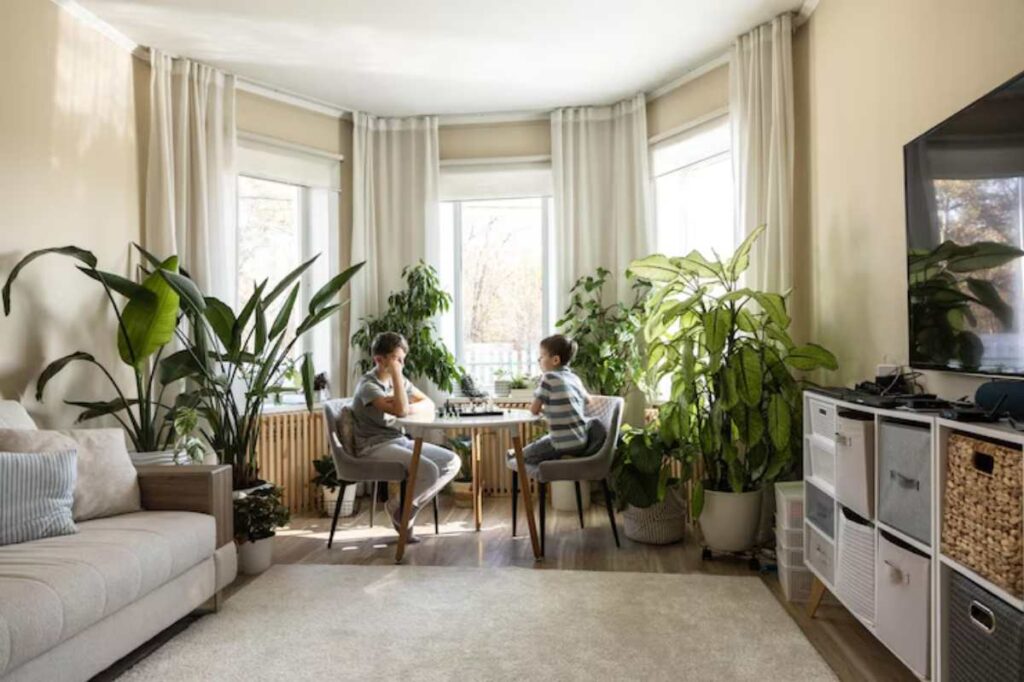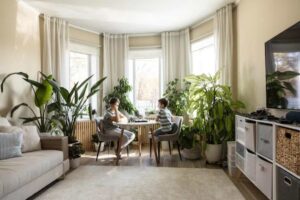The Interior Blog

Using Indoor Plants to Define Open Concept Living Areas
Open-concept living has become the gold standard in modern homes — it’s bright, airy, and makes smaller spaces feel expansive. But without walls to create structure, these large areas can often feel confusing or unfinished. Where does the dining zone stop? Where does the living area begin?
If this sounds familiar, you’re not alone.
That’s where indoor plants step in — quite literally — to draw invisible boundaries with life, texture, and flow. Whether you live in a city flat or a family home, using greenery to define your layout adds purpose without needing drywall or bulky furniture.
In this guide, we’ll explore how to use indoor plants to zone, anchor, and elevate open-plan living. We’ll offer beginner-friendly indoor design advice, practical styling tips, and real-life examples to help you bring order and beauty to your space.
Why use plants to define space?
You could always use rugs, bookshelves, or sofas to break up open layouts, and those options still work. But plants offer a softer, more flexible solution.
Here’s why they’re ideal for open space styling:
- They introduce vertical lines without closing off the space
- They soften hard furniture edges with organic shapes
- They improve air quality and acoustics naturally
- They’re adaptable — you can easily move or adjust them as your needs change
Plus, plants bring a sense of calm and presence. They guide the eye and encourage flow, helping large rooms feel both grounded and alive.
Zoning with plants: the basic principles
Before you start shopping, consider these fundamentals of using plants for zoning:
1. Function first
Ask yourself:
- What activities happen in this open space?
- Do I need privacy, separation, or just a sense of structure?
For example, if your home combines a dining and living area, you might want to create a visual buffer, not a hard block.
2. Think in layers
Just like a forest, the best plant arrangements use height variation: tall trees, mid-sized shrubs, and low-lying ground cover. This technique adds depth and helps you build invisible lines between zones.
3. Balance openness with definition
The goal isn’t to wall off areas completely. Instead, use plants to suggest boundaries while maintaining flow and sightlines.
The best indoor plants for open space styling
Some plants are better suited to zoning than others.
You want options that are:
- Tall and structural for clear visual lines
- Full and bushy to act as soft dividers
- Flexible and movable for smaller spaces
Here are some beginner-friendly favourites:
Tall Statement Plants
- Fiddle Leaf Fig — Upright and bold
- Strelitzia Nicolai (Bird of Paradise) — Tall and tropical
- Areca Palm — Soft, arching fronds are perfect for filtering space
Mid-Level and Bushy Plants

- Rubber Plant — Dense, shiny leaves in compact form
- Dracaena — Architectural lines and easy care
- Monstera Deliciosa — Lush and dramatic, great for corners
Trailing and Hanging Plants
- Pothos — Trailing elegance that defines edges
- String of Pearls — Cascades beautifully from the shelves
- Spider Plant — Adds volume and softness to high zones
Many of these also feature in our list of easiest indoor plants to style — perfect if you’re new to plant care.
Practical ways to zone your space using plants
Now that you know which plants to work with, let’s explore how to use them creatively and intentionally across different layouts.
1. Create a “living wall” divider
Using tall plants in a line or staggered cluster, you can form a natural screen that breaks up a long room.
For example:
- Place three fiddle leaf figs in matching pots between your dining area and lounge
- Use an open shelving unit filled with trailing plants to divide without blocking light
- Layer in different heights — a tall plant, a mid one, and a stool with a small pot
This method keeps areas distinct while letting the room breathe.
2. Anchor a furniture arrangement
Plants can help ground your furniture layout, especially in open living rooms.
Try:
- A large palm behind a sofa to define the sitting zone
- A rubber plant beside a low TV unit to draw the eye upwards
- Trailing pothos on a console table to separate walkways from seating
Using greenery as a natural “bookend” gives structure to otherwise floating furniture.
3. Frame entryways and transitions
Have an open doorway between the kitchen and the lounge? Use plants to visually frame it.
- Place matching plants (like snake plants or ZZ plants) on either side
- Use a tall plant on one side and a low one on the other to create asymmetry with balance
- Install a hanging plant above the threshold for vertical flow
This adds rhythm and intentionality to how you move through your space.
Styling tips for cohesion and flow
It’s not just where you place the plants — it’s how you style them.
Keep your planters cohesive
Stick to a colour palette or material theme:
- Terracotta and rattan for earthy tones
- White and grey ceramics for Scandi minimalism
- Black, brass, or concrete for modern interiors
Avoid too many contrasting styles — it can look busy or distracting.
Use plant stands and shelves

Elevating plants adds dimension and helps you:
- Vary plant heights for layered interest
- Avoid cluttering floors
- Frame sofas, chairs, or counters more effectively
Check out our guide on choosing the right pot size and shape to get the most from your display.
Repeat elements for visual rhythm
Repetition = harmony. Whether it’s repeating planter styles or echoing plant types across zones, this technique brings unity to large spaces.
Room-by-room ideas for plant-based zoning
Let’s break down a few real-life open-plan setups and how to use plants to enhance them.
Kitchen to Dining Area
Goal: Maintain visibility but create soft separation.
Try:
- A tall herb planter on a kitchen island
- A row of low succulents or ZZ plants as a centrepiece
- Hanging plants above the dining area to define it vertically
Dining to Lounge Area
Goal: Establish different functions while keeping openness.
Try:
- A large plant, like a Monster,a to mark the shift
- Console table between zones with trailing plants
- Floor-standing dracaenas flank either end of the sofa
Lounge to Home Office Nook
Goal: Encourage focus without full enclosure.
Try:
- A semicircle of plants around your desk
- A tall rubber plant beside the office chair
- Shelves with cascading plants to visually soften the area
This helps you mentally “switch on” and “switch off” from work — without closing off the space entirely.
Mistakes to avoid when zoning with plants

As inspiring as this sounds, it’s easy to get carried away.
Here are some common pitfalls:
- Overcrowding: Too many plants make spaces feel cluttered, not calming
- Wrong lighting: Make sure plants are suited to the light in their new zones
- Unstable pots: Especially in walkways, use weighted planters for safety
- Random placement: Think in lines and layers, not just “where there’s a gap.”
- Style clashes: Keep consistency in planters, tones, and plant shapes
Like any décor, thoughtful placement makes all the difference.
Conclusion: Let your space grow into something intentional
Open-plan living offers freedom, but without structure, it can lack comfort. Indoor plants offer the perfect balance: soft yet defined, mobile yet grounding, decorative yet functional.
By choosing the right greenery and positioning it with purpose, you can shape your space into distinct zones that still feel connected. Whether it’s marking a dining area, buffering a lounge, or setting up a peaceful home office, your plants can do more than just sit pretty — they can define your daily rhythm.
Ready to refresh your open space? Start small. Move one plant, create a corner, or build a plant shelf to divide and connect. Your layout will thank you — and so will your well-being.









